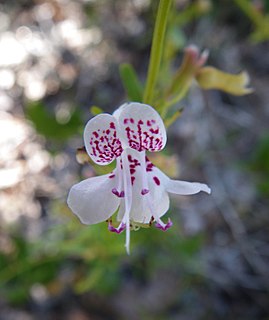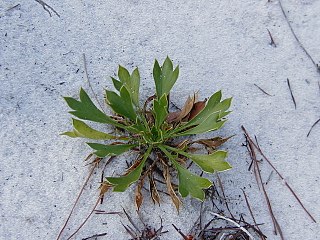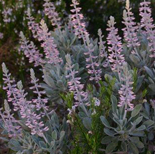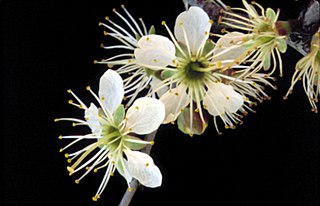The Florida peninsula inland scrub is a shrubland community found on the Florida peninsula. The largest remaining blocks of inland scrub are in and around the Ocala National Forest and in the Lake Wales Ridge National Wildlife Refuge. The Archbold Biological Station near Lake Placid contains about 20 km2 (7.7 sq mi) of scrub habitat and sponsors biological research on it. The scrub occurs on a series of north-south running ridges composed of sand derived from ancient dune fields. [1] The soil, a type of entisol, is derived from quartz and is low in organic matter, silt, and clay. [2] Because the low-nutrient sandy soils do not retain moisture, the ecosystem is effectively an arid one.

Florida is the southernmost contiguous state in the United States. The state is bordered to the west by the Gulf of Mexico, to the northwest by Alabama, to the north by Georgia, to the east by the Atlantic Ocean, and to the south by the Straits of Florida. Florida is the 22nd-most extensive, the 3rd-most populous, and the 8th-most densely populated of the U.S. states. Jacksonville is the most populous municipality in the state and the largest city by area in the contiguous United States. The Miami metropolitan area is Florida's most populous urban area. Tallahassee is the state's capital.

The Ocala National Forest ls the second largest nationally protected forest in the U.S. State of Florida. It covers 607 square miles (1,570 km2) of Central Florida. It is located three miles (5 km) east of Ocala and 16 miles (26 km) southeast of Gainesville. The Ocala National Forest, established in 1908, is the oldest national forest east of the Mississippi River and the southernmost national forest in the continental U.S. The word Ocala is thought to be a derivative of a Timucuan term meaning "fair land" or "big hammock". The forest is headquartered in Tallahassee, as are all three National Forests in Florida, but there are local ranger district offices located in Silver Springs and Umatilla.

The Lake Wales Ridge National Wildlife Refuge is part of the United States National Wildlife Refuge (NWR) System, located in four separated areas on the Lake Wales Ridge east of US 27 between Davenport and Sebring Florida. The 1,194 acre (4.8 km2) refuge was established in 1990, to protect a host of plants and animals. It is also the first to be designated primarily for the preservation of endangered plants, and is not open to the general public. It contains a high proportion of remaining Florida scrub habitat. It is administered as part of the Merritt Island National Wildlife Refuge.
The plants generally consist of xerophytic shrubs, especially oaks, with occasional pine trees. The understory is often sparse and sometimes absent, leaving only bare ground. Sand pine ( Pinus clausa ) is the typical pine. Oaks include Chapman oak ( Quercus chapmanii ), sand live oak ( Quercus geminata ), myrtle oak ( Quercus myrtifolia ), and the endemic Inopina oak ( Quercus inopina ). Other shrubs include rusty staggerbush ( Lyonia ferruginea ), saw palmetto ( Serenoa repens ), sandhill-rosemary ( Ceratiola ericoides ), scrub holly (Ilex opaca var. arenicola), scrub olive ( Osmanthus megacarpa ), scrub pawpaw ( Asimina obovata ), silk bay ( Persea humilis ), Adam's needle ( Yucca filamentosa ), and eastern prickly pear ( Opuntia humifusa ). [1] [3]

Pinus clausa is a species of pine endemic to the Southeastern United States. Its common names include sand pine, Florida spruce pine, Alabama pine, and scrub pine.

Quercus chapmanii, commonly referred to as the Chapman oak, is a species of oak that grows in the southeastern United States.

Quercus geminata, commonly called sand live oak, is an evergreen oak tree native to the coastal regions of the subtropical southeastern United States, along the Atlantic Coast from southern Florida northward to southeastern Virginia and along the Gulf Coast westward to southern Mississippi, on seacoast dunes and on white sands in evergreen oak scrubs.
Endangered plants of the Florida scrub include Florida golden aster ( Chrysopsis floridana ), Ashe's savory ( Calamintha ashei ), pygmy fringetree ( Chionanthus pygmaeus ), sandlace ( Polygonum dentoceras ), scrub plum ( Prunus geniculata ), short-leaved false rosemary ( Conradina brevifolia ), etonia rosemary ( Conradina etonia ), yellow scrub balm ( Dicerandra christmanii ), scrub beargrass ( Nolina brittoniana ), scrub blazingstar ( Liatris ohlingerae ), scrub lupine ( Lupinus aridorum ), and scrub morning glory ( Bonamia grandiflora ). [4]

Chrysopsis floridana is a rare species of flowering plant in the aster family, known by its common name, Florida golden aster. It is endemic to Florida in the United States, where it is known from Hillsborough, Hardee, Manatee, and Pinellas Counties. It is considered an endemic of the west-central coast of the state in the general vicinity of Tampa Bay. There are 17 to 20 occurrences, many of which have few individuals, but one of which has over one million plants. In 1986 the plant was added to the US endangered species list because it was becoming increasingly rare, it was growing only on private property, and its habitat was unprotected and being destroyed and degraded by a number of forces. It is found at Bell Creek Nature Preserve in Riverview, Florida.

Calamintha is a genus of plants that belongs to the family Lamiaceae. Commonly called the calamints, there are about eight species in the genus which is native to the northern temperate regions of Europe, Asia and America.

Chionanthus pygmaeus is a rare species of flowering plant in the olive family known by the common name pygmy fringetree. It is endemic to Florida, where there are 46 known occurrences as of 2010. The plant is found in increasingly rare habitat in Central Florida that is being consumed for development, and some protected areas are not managed adequately. Most populations are small. It is a federally listed endangered species of the United States.
Notable animals of the Florida scrub include the Florida scrub jay ( Aphelocoma coerulescens ), Florida mouse ( Podomys floridanus ), sand skink ( Neoseps reynoldsi ), bluetail mole skink ( Eumeces egregius lividus), Florida scrub lizard ( Sceloporus woodi ), and Florida worm lizard ( Rhineura floridana ). [5]
This community is often adjacent to Florida longleaf pine sandhills, which have a markedly different appearance. [1]
The Florida longleaf pine sandhill is a forest system found on sandhills in the coastal plains of northern Florida, ranging from the panhandle to the central peninsula. Particular examples can be found in Ocala National Forest and Eglin Air Force Base.














